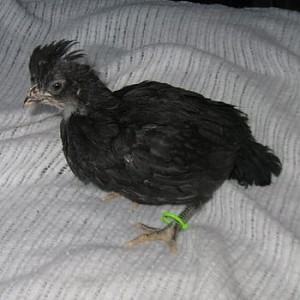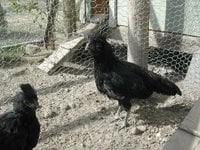For about 20 years, now, Crevecoeurs have been my favorite chickens.
I have had other chickens, including Ameraucanas, Delawares, Rocks, Nankins, Sultans, Houdans, Polish, Belgian d'Uccles, Booted Bantams, and Dominiques, to name a few of them.
The Crevecoeurs are the most easy-going of all. One year we had to lock all of them up together in a small shed because our barn was flooded. Twenty-eight of them, hens and roosters together, coexisted peacefully in a tight 6x6 foot space for almost three weeks until we got the roof fixed and the floor drained and dry. Their main complaint, voiced as the sun went down, was that the roosts weren't high enough. I have to say, in my experience they want to roost higher than most other chickens I have raised.
The roosters seem to still have all their courting instincts intact even as cockerels, unlike the Ameraucanas. I have put other chickens in with them, mostly Ameraucanas and Easter Eggers, and the roosters maintain order and prevent fighting among the hens, and call everyone for food and fresh straw in the nest boxes. You don't ever hear much squabbling in the Crevecoeur pens.
Crevecoeurs are non-setters, so I have used a combination of broodies (mostly Nankins) and incubators to maintain my flock over the years. My original Crevecoeurs were from Murray McMurray. More recently I have picked up a flock, which I am maintaining separately, of Crevecoeurs from Jeannette Beranger of the Livestock Conservancy. (I always try to maintain two separate flocks of the same breed, for breeding purposes.) Jeannette's Crevecoeurs are better layers than my original Murray McMurray flock. Over the years I selected my original flock for size and for meeting the APA standard, and I continue to show them in local fairs for the judge's opinions. Crevecoeurs stay good-looking and healthy longer than most of my other chicken breeds. At the Missouri State Poultry Association Show in 2015, I showed a Crevecoeur hen who took first place, Best of Breed, and best Continental, despite being 10 years old. Usually, I stop showing most of my chickens around 4-5 years old.
The Crevecoeur hens continue laying longer than most breeds and at a decent rate into their seventh and eighth year, then they age gracefully from egg producers into backyard pets.
(Addition in October 2018: The oldest Crevecoeur rooster I have right now is 14-1/2 years old, and the oldest hen will be 16 in February. And both sexes continue to eat bugs and weeds into their old age, giving you that chicken manure which, when composted, is the gold standard of compost for gardening.
I know I said they only come in black, but that's in the APA standard. France and England both accept white and blue in their standards. The white Crevecoeur was derived from a white sport, which has some smoky or sooty feathers. Jeannette Beranger gave me a white Crevecoeur sport, which you can see on her Facebook page for her Crevecoeur project. I have included photos of her foraging, and with her rooster, who is all black. I have hatched a lot of her eggs, and so far they were all blacks. Now, hatching some of the grandchildren, hoping to find another white sport, preferably a boy, but I will take what I get!)
Crevecoeurs are not heavy eaters, and they don't get fat even if they have more food available to them, unlike my Rocks and Delawares. They like to forage and I think their crests allow them to focus on the food search on the ground. Like most good foragers, they can be quite destructive in the garden; they are best used for plowing rather than for insect control. If they have nearby cover they are quite good at keeping out of the way of the flying predators, but I have lost a few to foxes and raccoons, the same as my other flock birds.
I keep the Crevecoeurs in outdoor cages, all year round. They have cover from the rain and snow, shade in the summer, and some wind protection in the winter. I make sure they have water to drink twice a day. The Crevecoeurs are hardy, and it's not unusual to see them out in the snow or rain, digging around. In subfreezing weather they occasionally develop icicles on their beards from dipping into their water; I do thaw out their beards sometimes, more for my comfort than theirs. I have now included a photo in my gallery, so you can see what this icing looks like. You will usually notice this because the Crevecoeur keeps flipping his/her head to see past the icicles!
Overall, if you are looking for a backyard laying hen or for eating, Crevecoeurs are great birds. Because they are rare, Crevecoeurs show well for kids in 4-H and junior shows. Crevecoeurs are hard-feathered birds, and can be easily washed and groomed for shows. Crevecoeurs in this country mostly come in the one color, black, but they always manage to make it look good!




































